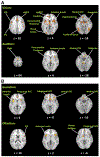Naturalizing aesthetics: brain areas for aesthetic appraisal across sensory modalities
- PMID: 21699987
- PMCID: PMC8005853
- DOI: 10.1016/j.neuroimage.2011.06.012
Naturalizing aesthetics: brain areas for aesthetic appraisal across sensory modalities
Abstract
We present here the most comprehensive analysis to date of neuroaesthetic processing by reporting the results of voxel-based meta-analyses of 93 neuroimaging studies of positive-valence aesthetic appraisal across four sensory modalities. The results demonstrate that the most concordant area of activation across all four modalities is the right anterior insula, an area typically associated with visceral perception, especially of negative valence (disgust, pain, etc.). We argue that aesthetic processing is, at its core, the appraisal of the valence of perceived objects. This appraisal is in no way limited to artworks but is instead applicable to all types of perceived objects. Therefore, one way to naturalize aesthetics is to argue that such a system evolved first for the appraisal of objects of survival advantage, such as food sources, and was later co-opted in humans for the experience of artworks for the satisfaction of social needs.
Copyright © 2011 Elsevier Inc. All rights reserved.
Figures




References
-
- Ackermann H, Riecker A, 2004. The contribution of the insula to motor aspects of speech production: a review and a hypothesis. Brain Lang. 89, 320–328. - PubMed
-
- Allman JM, Watson KK, Tetresault NA, Hakeem AY, 2005. Intuition and autism: a possible role for Von Economo neurons. Trends Cogn. Sci. 9, 367–373. - PubMed
-
- Anderson AK, Christoff K, Stappen I, Panitz D, Ghahremani DG, Glover G, Gabrieli JDE, Sobel N, 2003. Dissociated neural representations of intensity and valence in human olfaction. Nat. Neurosci. 6, 196–202. - PubMed
-
- Bechara A, Damasio AR, 2005. The somatic marker hypothesis: a neural theory of economic decision. Games Econ. Behav. 52, 336–372.
Publication types
MeSH terms
Grants and funding
LinkOut - more resources
Full Text Sources

